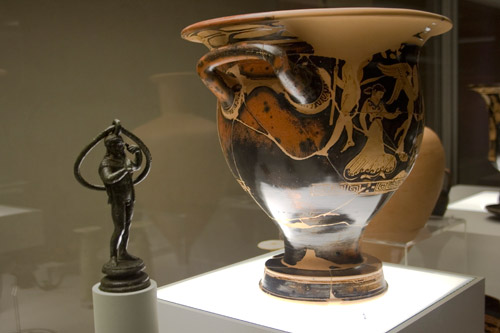
Room VI
In the first half of the fourth century BC Spina was still not feeling the effects of the greatest crisis sweeping through Northern Italy and Athens. Athenian defeat in the Peloponnesian War, the new presence in the Adriatic Sea of the tyrant Dionysius of Syracuse, who had laid his bases in Adria and Ancona in 390 BC, and the gradual penetration of Celtic tribes in the Po Valley, had led to major political and economic transformations. Even after the Boii Gauls conquered Felsina (Bologna) and Marzabotto, the last centres of Etruscan resistance, Spina, which had become the gathering point of many Etruscan refugees from the internal areas, succeeded in maintaining its prerogative of an autonomous free port open to the eastern markets for several years.

The presence of Attic red-figure pottery, even though diminishing from the mid-century, continues to prevail amongst pottery imports from siceliote and italiote factories that in this period are not of inferior quality. The privileged relationship between Spina and Athens can perhaps, once again, find its reason in Athens necessity for food supplies.
.jpg)
Objects of different productions (from Corinth and Rhodes also), and of great prestige, such as Greek phialai (plates) in embossed silver and magnificently carved Etruscan artifacts in bronze, maintain high the level of the tombs in the first half of the fourth century BC.
An example of this is a female tomb (136A of Valle Pega) characterized by a large Attic krater with openwork volutes, on a particularly elegant base, with red-figure paintings representing episodes of the fall of Troy (Ilioupersis) in the Mannerist style following the work of the painter Meidias. With it are Attic vases painted in black, particularly suited to the taste of the client, tableware in local ceramics and a rich bronze service with banqueting implements and a pair of candelabra surmounted by a frieze with a symbolic representation (Hermes Psychopompus leads the deceased to the Underworld). The presence alabastra, perfume bottles of Egyptian origin (in alabaster), a gold embossed crown with Amazons on horseback, Silenus and rosettes, all of which are products of Etrusco-padan workshops based on jewel models of Taranto, also allude to the high-rank of the woman buried in this tomb.

Imported products of different periods are gathered in the tomb 58C of Valle Pega. It belongs to another rich and cultured woman of Spina who also brings with her to the Afterlife bronze objects and a golden diadem with ivy leaves and vines. In this tomb the vessels, among which is also a banqueting service, can be dated throug fifty years.
Sometimes it is the representations on the vases, rather than the objects that suggest a feminine sphere through episodes of everyday life or references to tragic stories of women. One example is the tomb 264 of Valle Trebbawith a kylix (cup with two handles) displaying the murder of Cassandra committedby Clytemnestra, a mythological scene of extreme rarity, and two oinochoai (pitchers) with scenes of the Gynaeceum.
Room VII
Spina is a complex and socially varied centre. Its seaport status opens it to contacts with the peoples that cross the Adriatic and with those from the hinterland. Families and individuals came to the city carrying with them their well defined and never completely forgotten identities, even after their integration into the social structure of the city.
Some personal names engraved on pottery to indicate their possessor as well as some peculiar household goods refer to the Veneto area, particularly of the Adria territory and further up north. A significant example is the equipment of the tomb 185A of Valle Pega, dated to the mid-fourth century BC, with two bronze situlefrom the Venetocentre of Este, probably the woman’s rich dowry. The presence of situle, vessels for the transport of water or other liquids, together with bronze belt plates with decorative motifs of Venetian inspiration, , can be explained with the fact that the tomb belongs to a woman, who perhaps came to Spina for marriage from the nearby Veneto area.
The most prestigious objects, placed in prime position next to the head, are the two etruscan-padan candelabra surmounted by a figurine of a naked warrior armed with an Attic crested helmet, round hoplite shield and spear, a manifestation of military ideology still lingering in the IV century BC in some upper classes of Spina. Despite the masculine connotation of the depicted subjects, the two candelabra are interpreted by some scholars as a further affirmation of the deceased to an elevated social class, so high as to permit the the purchase and maintenance of the hoplite panoply, the armament of the heavy infantry that in the fifth century BC boasts a large organization in Padan Etruria.
Next room